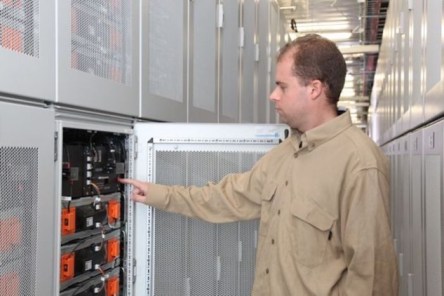Late last month, Southern California Edison switched on its newest substations, an 80MWh lithium-ion battery storage facility that will manage peak demand and improve grid reliability. Just off Interstate 15, nestled in the heart of California’s Riverside County, one of the world’s biggest energy storage projects recently roared to life. Part of a collaboration between Tesla and Southern California Edison (SCE), the installation at the Mira Loma substation will be used to manage peak energy demand and stabilize the grid. “Upon completion, this system will be the largest lithium-ion battery storage project in the world,” declares a Tesla blog post announcing the project. “When fully charged, this system will hold enough energy to power more than 2,500 households for a day or charge 1,000 Tesla vehicles.” Managing Peak Energy The Mira Loma project is one of the first to use Tesla’s new Powerpack 2 for utility-scale energy storage. With an 80 MWh capacity, the 400 Powerpacks will allow SCE to manage energy use during peak hours. The Powerpacks will be charged with electricity generated during off-peak hours and then supplement demand during periods of peak demand. This process will not only save energy; it will allow SCE to maintain grid reliability, deliver better power quality to customers and reduce dependence on fossil fuels. “The system will charge using electricity from the grid during off-peak hours and then deliver electricity during peak hours to help maintain the reliable operation of Southern California Edison’s electrical infrastructure which feeds more than 15 million residents,” explains the Tesla statement. “By doing so, the Tesla Powerpack system will reduce the need for electricity generated by natural gas and further the advancement of a resilient and modern grid.” Future Expansion Larger utility-scale energy storage projects are already in the works...
Efficiency Reigns
Commercial Survey
If you haven’t prioritized the energy efficiency of your commercial properties, you’ve already fallen behind the curve. Corporate mandates requiring the lease of green buildings have nearly tripled. Prospects are willing—and now able—to pay a premium for energy efficient spaces. The Institute of Building Efficiency issued a survey to 687 VPs, facilities managers, owners and C-level personnel across the nation. Their buildings range from under 50,000 square feet to beyond 500,000 square feet. The results of the report revealed that energy efficiency has become a top priority and growing investment for building owners. When asked about their views on energy efficiency, 46 percent of survey respondents said they paid “a lot more” attention to energy efficiency in the previous 12 months than they had in prior years. Of the executives surveyed, 68 percent plan on increasing their investments in efficiency and renewables. In the past, third-party rebates and incentives furnished the bulk of financing for commercial efficiency upgrades. Yet with such resources dwindling, owners are earmarking monies within their own budgets. Financing called “energy- or climate-specific set-asides within the capital budget” nearly doubled last year to 30 percent from 17 percent in 2012. Meanwhile, energy service agreements increased to 32 percent from 21 percent in 2012/2013. The benefits of energy efficiency have proven their worth. Executives, managers, and tenants choose energy efficient buildings over conventional buildings. This year, 36 percent of respondents expressed that they would be willing to pay top dollar for an efficient space. This is more than double the 15 percent of participants who reported that they would pay a premium in 2013. Many are willing to pay the premium because efficient spaces are a mounting requirement by leadership. 10 percent of respondents reported that corporate policy mandates the lease of...


